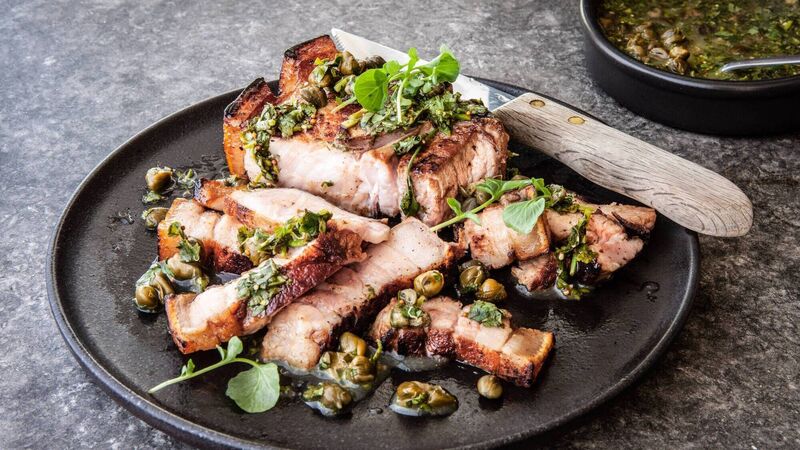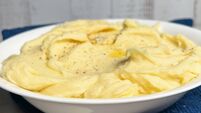Grill masters: The experts share five of their go-to barbecue recipes for summer

Pork porterhouse with salsa verde
Cooking the lamb in the oven first and then charring it on the BBQ is a really good way to dip your toes in to the BBQ world. Straight up, the oven-then-BBQ method works a treat, removes stress and allows you to focus on a couple of garnishes and the sauce delivers that punch. No one will know you did the sneaky oven trick and you can always do it the full way on the BBQ the next time you give it a lash. We’d rather you try this dish with a cheat or two than not at all. Just make sure to slather the lamb in a the marinade with lots of salt and lots of pepper. The mother sauce recipe makes a bit more than you need, but trust me, you’ll want the leftovers in your fridge for the midnight snackages.
Barry’s lamb shoulder with mother sauce with Gaz’s oven to BBQ method
Award-winning chef Gaz Smith and butcher Rick Higgins say cooking the lamb in the oven first and then charring it on the BBQ is a really good way to dip your toes in to the BBQ world

Servings
6Preparation Time
16 minsCooking Time
4 hours 0 minsTotal Time
4 hours 16 minsCourse
MainIngredients
2kg free-range lamb fore shoulder
Sunflower oil
Fine sea salt and freshly ground black pepper
For the mother sauce:
200g fresh flat-leaf parsley
200g fresh chives
100g fresh mint
80g capers
3 garlic cloves, peeled
300ml olive oil
Zest of 3 lemons and 100ml juice
2 tablespoons honey
50ml red wine vinegar
1 heaped teaspoon ground cumin
1 teaspoon chilli flakes
To serve:
A squeeze of lemon
Method
To make the mother sauce, blitz all the ingredients in a food processor or blender and store in the fridge until ready to use.
To make the lamb, preheat the oven to 200°C.
Lightly score the skin of the lamb using a small sharp knife in a 2cm criss-cross pattern.
Rub a glug of sunflower oil all over the meat and put the lamb on a baking tray, then season well with salt (say, three good pinches) and a generous seasoning of pepper. Cover the tray securely with foil.
Roast in the oven for 45 minutes, then turn the heat down to 120°C and roast for a further 3–4 hours or as long as you want. Bear in mind, though, that if you cook it for longer than 4 hours, you’ll need to turn the oven down to 100°C.
An hour before you’re ready to eat, light your BBQ and wait for the coals to go white. Your lamb will be tender by this stage but still firm enough to lift on and off the BBQ. For this method you don’t need any faffing with onset or offset coals, as the lamb will be fully cooked already, but whacking it over a high heat will give the lamb some colour and that magnificent char we all love. So you want nice high coals and a nice hight heat, like doing a steak. You’ve done the hard work, now let’s flame it up and enjoy it.
Simply place the lamb over the high heat and close the lid with the vents three-quarters of the way closed. You want that bad boy up to 400°C+ and flames licking the meat for a good 5–6 minutes. Turn it over and pour the tray juices and fats over for the final few minutes. It will flare up and sizzle but only for a minute, so roll with it.
A lot of chefs will disagree, but I always go for a really, really good char, even if it’s slightly burnt. It’s only the exterior – the interior will be juicy and sweet and the sauce will bring it all together.
Just before serving, drizzle the lamb with 6–7 tablespoons of mother sauce and a big squeeze of lemon.
Gaz says a pork porterhouse is essentially a T-bone steak, but when it’s from a cow, it’s a steak, and when it’s from a pig, it’s a chop. There is, however, definitely a difference in the way you cook it. Pork isn’t as forgiving as beef – while it’s got the nice thick fat cap, it has very little fat actually going through the meat. It also cooks far quicker than you might expect.
I love pork for its richness and fattiness, but you need something sharp to cut through all that. This salsa has a load of really zesty, zingy, fresh flavours in it and they cut through it all perfectly. It’s exactly what you want to serve with pork – something nice and zappy.
This goes well with asparagus, tenderstem broccoli, spuds, rice or even a slice of bread. Have I mentioned that I quite like crusty white bread?
Pork porterhouse with salsa verde
By chef Gaz Smith and butcher Rick Higgins. A pork porterhouse is essentially a T-bone steak, but when it’s from a cow, it’s a steak, and when it’s from a pig, it’s a chop.

Servings
2Cooking Time
20 minsTotal Time
20 minsCourse
MainIngredients
2 x 400g pork porterhouse chops
Fine sea salt and freshly ground black pepper
1 tbsp butter
2 garlic cloves, thinly sliced
A handful of fresh flat-leaf parsley, finely chopped
To serve:
2 tbsp salsa verde
Method
Season your pork chops with salt and pepper. Score the fat three or four times – this will help the chops to stay flat on the BBQ and not curl up.
If you’ve ever cooked a steak on a BBQ, this is the same method: nice high heat, white ashes, beer in hand and the fattest pork chops you can lay your mitts on.
Now this bit sounds complicated, but it isn’t. With a pair of tongs, hold your chops over the hot coals, fat side down, and keep them there. A good pork chop should stand up on its own, but you don’t want it to fall through the grates. A little ball of tin foil on either side of the chops will save your arms being burnt off. Cook it like this until the fat has sizzled, charred a bit and rendered down. There will be a bit of flare-up from the BBQ, but as you may know by now, I love a good flare-up.
Once you’ve completed the above step, turn both the chops over onto their sides over a medium-high heat (your probe should read about 250°C) for 4 minutes, until browned with lovely char marks. Don’t touch them. They will likely stick, but if you just back away, they’ll unstick themselves. Whatever you do, don’t yank them off the grill if they’re stuck, you lunatic – hold tight, it’ll all come good. Turn them over and repeat on the other side for a further 5 minutes, until browned and caramelised. Transfer the chops to a large plate or platter.
Put the butter, garlic and parsley in a small saucepan over a medium heat and allow the butter to melt. Cut the meat away from bone, then carve the meat into strips and pour all the buttery, garlicky juices over the chops. Take a moment to admire their beauty.
Serve with a tablespoon of the salsa verde spooned on top. I always serve these with corn on the cob that I lash onto the now slightly cooled BBQ with the lid on as the chops relax.
This is one of our classic go-to sauces. It’s zingy, sharp and packed with flavour. It’s brilliant drizzled over a roasted chicken, a leg of lamb or some fresh fish. But it’s equally good thrown in a sandwich or with some leftover meat cold out of the fridge.
I sometimes add an extra dash of white wine vinegar just before using, but I’m a whore for really sharp dressings. If you’re the same, give it a go, particularly if it’s been sitting in the fridge for a few days.
It might seem a little strong when you taste it, but when it’s drizzled over something, all the flavours will balance themselves out.
Salsa verde
By chef Gaz Smith and butcher Rick Higgins. This salsa has a load of really zesty, zingy, fresh flavours in it.

Servings
2Cooking Time
5 minsTotal Time
5 minsCourse
SideIngredients
100g fresh basil leaves
25g fresh flat-leaf parsley
20g fresh tarragon leaves
6 garlic cloves, minced
150ml vegetable oil
80ml extra virgin olive oil
4 tbsp white wine vinegar
4 tbsp wholegrain mustard
3 tbsp Dijon mustard
2 tbsp Colman’s mint sauce
2 tsp fine sea salt
Method
- Place all the ingredients in the bowl of a food processor and whizz to form a thick, smooth consistency. This will keep in an airtight container in the fridge for a good few days.
Barry says I’m blessed to have a really good Pakistani shop over the road from 147 Deli. We go over all the time and it’s just amazing. There are brands he has there that I’ve never heard of before. You open them up and you can really smell the difference. Spices like that make a huge difference to a dish.
Monkfish is a beautiful meaty fish, so it can handle a strong marinade or a lot of flavour. It’s like the pork of the fish world. It works so well on a barbecue and it can also take that charring on the outside. It’s not a delicate fish – you can really batter the thing.
Indian-spiced monkfish
By chef Gaz Smith and butcher Rick Higgins. Monkfish is like the pork of the fish world. It works so well on a barbecue and it can also take that charring on the outside.

Servings
3Preparation Time
6 hours 0 minsCooking Time
40 minsTotal Time
6 hours 40 minsCourse
MainIngredients
1 x 700g monkfish tail
Juice of 1 lime
For the marinade:
4 tablespoons vegetable oil
2 tablespoons hot curry powder
1 tablespoon honey
½ tablespoon nigella seeds
1 teaspoon fenugreek seeds
1 teaspoon fine sea salt
1 teaspoon freshly ground black pepper
Zest and juice of 1 lemon
200ml coconut milk
Method
You want to make the marinade either first thing in the morning or the night before you’re going to be barbecuing.
Heat up your vegetable oil in a small saucepan over a medium heat and fry off the hot curry powder for 2–3 minutes. Add the honey, nigella seeds, fenugreek seeds, salt and pepper and stir to combine, then add the lemon zest and juice and coconut milk. Turn the heat down to low and bring the whole lot to a gentle simmer for 5 minutes, stirring regularly. Remove from the heat and let it cool completely.
Slather the monkfish in the marinade and leave it to absorb all the flavours for at least 6 hours, but preferably 12. Retain a bit of the marinade so you can brush the monkfish with it while it’s on the barbecue.
When you’re ready to barbecue, cook the monkfish tail over an indirect heat for 20 minutes, then for 6 minutes over the hot coals. Use the remaining marinade to brush it all over the tail as it cooks.
Squeeze over the lime juice before serving.
Rick says the story behind the hanger is a bit of a mindblower. There’s only one tiny little hanger per animal, weighing in at 600–700g. When you consider that the average heifer carcass can be up to 300kg, suddenly the hanger looks a little bit like a pearl hiding in an oyster. Traditionally, it was always known as a butcher’s treat because they’d nab it to take it home for their own dinner.
A hanger is actually considered an offal, which is why it has a very deep and unique flavour. You need to be careful with it, though, because the longer you cook it, the tougher it gets.
It’s not exactly a pretty steak – there’s a sinew that runs down the middle (which your butcher can remove for you) that makes it a little irregular in shape. But who cares what it looks like when it tastes this good?
The best way to cook a hanger is on a high heat with a good long resting time. It also loves an overnight marinade, particularly one that includes some sort of citric acid, as this will break down any fibres and make it a little more tender.
Hanger steak
By chef Gaz Smith and butcher Rick Higgins. The best way to cook a hanger is on a high heat with a good long resting time. It also loves an overnight marinade.

Servings
1Preparation Time
15 minsCooking Time
20 minsTotal Time
35 minsCourse
MainIngredients
Hanger steak
Sea salt
Method
Remove the steak from the fridge a few hours before cooking to bring to room temperature. Season the steak with good-quality sea salt when you take it out of the fridge.
Oil the steak just before cooking, then whack it on a really hot pan or barbecue until it reaches 48°C internally.
Allow it to rest for at least 15 minutes before carving.
- This article was first published on May 24, 2022.









